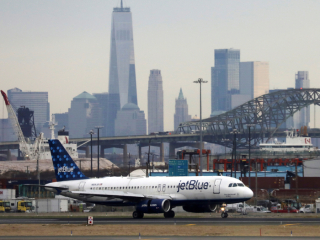On Friday, April 5, a magnitude 4.8 earthquake rocked eastern New Jersey, causing buildings to shake for up to 30 seconds. The shaking was felt as far North as Albany in New York and south as Wilmington in Delaware. Following the earthquake, there were no reported deaths or injuries; the only damage to be noted was weaker buildings. Friday’s earthquake was one of the largest felt across the Northeast in recent years.
Ground Stops
The Federal Aviation Administration (FAA) issued ground stops at the airports closest to the epicenter in response to the earthquake. The airports affected by ground stops included Newark Liberty Int’l Airport (EWR) and New York John F. Kennedy Int’l (JFK). The FAA ground stop was issued as a precaution while workers at these airports assessed airport facilities for any damage caused by the brief earthquake.
The ground stop at JFK was lifted first at around 11:10 a.m. local time, while the EWR ground stop was lifted around 20 minutes later at 11:30 a.m. local time. Delays at JFK following the ground stop were less significant than in Newark, with JFK reporting an average 20-minute delay for flights departing the airport. In Newark, however, for some unlucky flights, this delay time was as high as one hour.
During earthquakes, it is standard operating procedure for airport facilities to cease operations while the tremors occur. Some airports, such as those in Japan, are prone to powerful, long earthquakes, but they are built to withstand more powerful quakes and have developed procedures to follow after a powerful earthquake. At Narita Airport (NRT) in Tokyo, if an earthquake of a certain magnitude or greater is detected, an announcement will sound, notifying passengers to stay calm and away from windows, walls, and pillars.
If an earthquake is powerful enough in Japan, the terminal buildings will be evacuated, with airport employees bringing passengers outside on the tarmac. Following the Tōhoku earthquake in March 2011, all flights out of Japanese airports north of Tokyo were canceled.
Most airports in Asia along the so-called "Ring of Fire" are built to an extent to withstand strong earthquakes. Following the April 4 Hualien City earthquake in Taiwan, air travel out of many of Taiwan's major international airports continued as normal, with only minor damage and delays reported from airlines. Some airports in Southern Japan were closed temporarily following the earthquake but have since reopened with minimal disruptions.
Most aircraft landing gears are built with shock absorbers to withstand hard landings. This means that an aircraft's landing gear will absorb most of the quake's tremors during an earthquake, leading to the aircraft being unaffected and undamaged.
Besides potentially affecting airport buildings and the sensitive radio and electrical equipment inside them, earthquakes can also affect airport runways through a process known as liquefaction. Liquefaction occurs when the rapid shaking of the ground during an earthquake causes the soil underground (typically soil with a higher amount of water) to act as a liquid. Liquefaction can no longer support the weight above it.
This means that if an earthquake is powerful enough to cause the liquefaction of the soil beneath an airport runway, the runway will crack and buckle, leaving it unusable to air traffic afterward. Certain organizations, such as Oregon State University, are studying the effects a major earthquake might have on U.S. airports - in this case, Portland Intl Airport (PDX) in Oregon.
Passengers Encounter Bedbug Infestation on Multiple Turkish Airlines Flights » Bomb Threat Cancels Air New Zealand Flight, Delays Passengers » Emirates Dismisses Viral A330 Plane Crash Video as "Fabricated and Untrue" »
Comments (0)
Add Your Comment
SHARE
TAGS
NEWS earthquakeNew YorkEWRJFKUnited AirlinesAmerican AirlinesFAAUnited StatesDelta AirlinesNew JerseyGround stopRECENTLY PUBLISHED
 Could You Survive a Plane Crash? The Unlikely Science of Plane Crash Survival
With air travel consistently being heralded as the safest form of public transport, most of us do not board a plane pondering our chances of survival in the event of a crash. But, is it possible to survive one?
INFORMATIONAL
READ MORE »
Could You Survive a Plane Crash? The Unlikely Science of Plane Crash Survival
With air travel consistently being heralded as the safest form of public transport, most of us do not board a plane pondering our chances of survival in the event of a crash. But, is it possible to survive one?
INFORMATIONAL
READ MORE »
 Maldivian Airlines Introduces First-Ever Widebody Aircraft, Plans New China Flights
Maldivian, the government-owned national airline of the Maldives, has just welcomed its first-ever wide body aircraft: the Airbus A330-200. With the new aircraft, the carrier also plans brand-new long haul international flights to China.
NEWS
READ MORE »
Maldivian Airlines Introduces First-Ever Widebody Aircraft, Plans New China Flights
Maldivian, the government-owned national airline of the Maldives, has just welcomed its first-ever wide body aircraft: the Airbus A330-200. With the new aircraft, the carrier also plans brand-new long haul international flights to China.
NEWS
READ MORE »
 Thousands of Flights Impacted as Winter Storm Blair Hits U.S.
Winter Storm Blair has unleashed a huge blast of snow, ice, and freezing temperatures across the Central and Eastern United States.
As of Sunday afternoon, over 6,700 flights and counting have been disrupted. This includes cancelations and significant delays leaving passengers scrambling to change flights and adjust travel plans.
NEWS
READ MORE »
Thousands of Flights Impacted as Winter Storm Blair Hits U.S.
Winter Storm Blair has unleashed a huge blast of snow, ice, and freezing temperatures across the Central and Eastern United States.
As of Sunday afternoon, over 6,700 flights and counting have been disrupted. This includes cancelations and significant delays leaving passengers scrambling to change flights and adjust travel plans.
NEWS
READ MORE »





